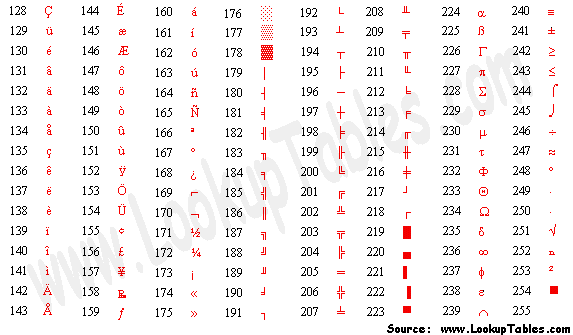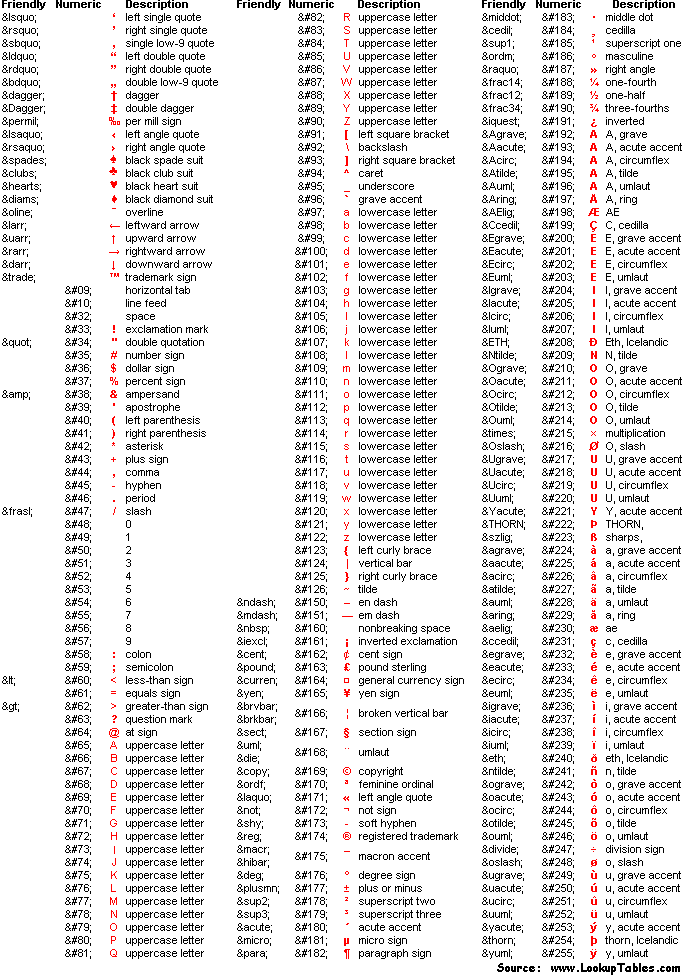Commonly Used
ASCII and ANSI Characters
Note: To
type these Characters, you must turn on NumLock,
then use the Number Key Pad and NOT the numbers at the top of the keyboard.
In the Germanic languages, Diaeresis is
referred to as an Umlaut.
|
Character (Name) |
ANSI
|
ASCII
|
|
Character (Name) |
ANSI
|
ASCII
|
|
Ä (A Diaeresis) |
ALT+0196 |
ALT+142 |
|
ä (a Diaeresis) |
ALT+0228 |
ALT+132 |
|
Ë (E Diaeresis) |
ALT+0203 |
---- |
|
ë (e Diaeresis) |
ALT+0235 |
ALT+137 |
|
Ï (I Diaeresis) |
ALT+0207 |
---- |
|
ï (i Diaeresis) |
ALT+0239 |
ALT+139 |
|
Ö (O Diaeresis) |
ALT+0214 |
ALT+153 |
|
ö (o Diaeresis) |
ALT+0246 |
ALT+148 |
|
Ü (U Diaeresis) |
ALT+0220 |
ALT+154 |
|
ü (u Diaeresis) |
ALT+0252 |
ALT+129 |
|
Ÿ (Y Diaeresis) |
ALT+0159 |
---- |
|
ÿ (y Diaeresis) |
ALT+0255 |
ALT+152 |
|
ß (German Double SS-Caps & non-caps) |
ALT+0223 |
ALT+225 |
|
ƒ (Florin Monetary Unit) |
ALT+0131 |
ALT+159 |
|
™ (Unregistered Trademark) |
ALT+0153 |
---- |
|
® (Registered Trademark) |
ALT+0174 |
---- |
|
© (Copyright Symbol) |
ALT+0169 |
---- |
|
¼ (One-Fourth) |
ALT+0188 |
ALT+172 |
|
½ (One-Half) |
ALT+0189 |
ALT+171 |
|
¾ (Three-Fourths) |
ALT+0190 |
---- |
|
× (Multiplication Symbol) |
ALT+0215 |
---- |
|
÷ (Division Symbol) |
ALT+0247 |
ALT+246 |
|
¹ (Superscript 1) |
ALT+0185 |
---- |
|
² (Superscript 2) |
ALT+0178 |
ALT+253 |
|
³ (Superscript 3) |
ALT+0179 |
---- |
|
€ (Euro Monetary Symbol) |
ALT+0128 |
---- |
|
¢ (Cent Monetary Symbol) |
ALT+0162 |
ALT+155 |
|
£ (Pound Monetary Symbol) |
ALT+0163 |
ALT+156 |
|
‘ (Open Single Quote) |
ALT+0145 |
---- |
|
’ (Close Single Quote) |
ALT+0146 |
---- |
|
“ (Open Double Quote) |
ALT+0147 |
---- |
|
” (Close Double Quote) |
ALT+0148 |
---- |
|
‹ (Left Single Guillemet) |
ALT+0139 |
---- |
|
› (Right Single Guillemet) |
ALT+0155 |
---- |
|
« (Left Double Guillemet) |
ALT+0171 |
ALT+174 |
|
» (Right Double Guillemet) |
ALT+0187 |
ALT+175 |
|
¦ (Broken Bar) |
ALT+0166 |
---- |
|
– (En Dash) |
ALT+0150 |
---- |
|
— (Em Dash) |
ALT+0151 |
---- |
|
… (Ellipsis) |
ALT+0133 |
---- |
Complete ASCII & ANSI Character Chart
(Characters 1-127
are not on the Chart, since they are either ones that are used in
programming, or are already available on the keyboard.)
|
Character (Name) |
ANSI
|
ASCII
|
|
Character (Name) |
ANSI
|
ASCII
|
|
À (A Grave) |
ALT+0192 |
---- |
|
à (a Grave) |
ALT+0224 |
ALT+133 |
|
Á (A Acute) |
ALT+0193 |
---- |
|
á (a Acute) |
ALT+0225 |
ALT+160 |
|
 (A Circumflex) |
ALT+0194 |
---- |
|
â (a Circumflex) |
ALT+0226 |
ALT+131 |
|
à (A Tilde) |
ALT+0195 |
---- |
|
ã (a Tilde) |
ALT+0227 |
---- |
|
Ä (A Diaeresis) |
ALT+0196 |
ALT+142 |
|
ä (a Diaeresis) |
ALT+0228 |
ALT+132 |
|
Å (A Ring) |
ALT+0197 |
ALT+143 |
|
å (a Ring) |
ALT+0229 |
ALT+134 |
|
È (E Grave) |
ALT+0200 |
---- |
|
è (e Grave) |
ALT+0232 |
ALT+138 |
|
É (E Acute) |
ALT+0201 |
ALT+144 |
|
é (e Acute) |
ALT+0233 |
ALT+130 |
|
Ê (E Circumflex) |
ALT+0202 |
---- |
|
ê (e Circumflex) |
ALT+0234 |
ALT+136 |
|
Ë (E Diaeresis) |
ALT+0203 |
---- |
|
ë (e Diaeresis) |
ALT+0235 |
ALT+137 |
|
Ì (I Grave) |
ALT+0204 |
---- |
|
ì (i Grave) |
ALT+0236 |
ALT+141 |
|
Í (I Acute) |
ALT+0205 |
---- |
|
í (i Acute) |
ALT+0237 |
ALT+161 |
|
Î (I Circumflex) |
ALT+0206 |
---- |
|
î (i circumflex) |
ALT+0238 |
ALT+140 |
|
Ï (I Diaeresis) |
ALT+0207 |
---- |
|
ï (i Diaeresis) |
ALT+0239 |
ALT+139 |
|
Ò (O Grave) |
ALT+0210 |
---- |
|
ò (o Grave) |
ALT+0242 |
ALT+149 |
|
Ó (O Acute) |
ALT+0211 |
---- |
|
ó (o Acute) |
ALT+0243 |
ALT+162 |
|
Ô (O Circumflex) |
ALT+0212 |
---- |
|
ô (o Circumflex) |
ALT+0244 |
ALT+147 |
|
Õ (O Tilde) |
ALT+0213 |
---- |
|
õ (o Tilde) |
ALT+0245 |
---- |
|
Ö (O Diaeresis) |
ALT+0214 |
ALT+153 |
|
ö (o Diaeresis) |
ALT+0246 |
ALT+148 |
|
Ø (O with Oblique) |
ALT+0216 |
---- |
|
ø (o with Oblique) |
ALT+0248 |
---- |
|
Ù (U Grave) |
ALT+0217 |
---- |
|
ù (u Grave) |
ALT+0249 |
ALT+151 |
|
Ú (U Acute) |
ALT+0218 |
---- |
|
ú (u Acute) |
ALT+0250 |
ALT+163 |
|
Û (U Circumflex) |
ALT+0219 |
---- |
|
û (u Circumflex) |
ALT+0251 |
ALT+150 |
|
Ü (U Diaeresis) |
ALT+0220 |
ALT+154 |
|
ü (u Diaeresis) |
ALT+0252 |
ALT+129 |
|
Ý (Y Acute) |
ALT+0221 |
---- |
|
ý (y Acute) |
ALT+0253 |
---- |
|
Ÿ (Y Diaeresis) |
ALT+0159 |
---- |
|
ÿ (y Diaeresis) |
ALT+0255 |
ALT+152 |
|
Æ (AE Ligature) |
ALT+0198 |
ALT+146 |
|
æ (ae Ligature) |
ALT+0230 |
ALT+145 |
|
Π(OE Ligature) |
ALT+0140 |
---- |
|
œ (oe Ligature) |
ALT+0156 |
---- |
|
Ç (C Cedilla) |
ALT+0199 |
ALT+128 |
|
ç (c Cedilla) |
ALT+0231 |
ALT+135 |
|
Ñ (N Tilde, also Spanish N "enya") |
ALT+0209 |
ALT+165 |
|
ñ (n Tilde, also Spanish n "enya") |
ALT+0241 |
ALT+164 |
|
¬ (Not) |
ALT+0172 |
---- |
|
ß (German Double SS-Caps & non-caps) |
ALT+0223 |
ALT+225 |
|
ƒ (Florin Monetary Unit) |
ALT+0131 |
ALT+159 |
|
Š (S Caron) |
ALT+0138 |
---- |
|
š (s Caron) |
ALT+0154 |
---- |
|
Ž (Z Caron) |
ALT+0154 |
---- |
|
ž (z Caron) |
ALT+0154 |
---- |
|
þ (Icelandic Thorn) |
ALT+0254 |
---- |
|
Þ (Icelandic thorn) |
ALT+0222 |
---- |
|
Ð (Icelandic Eth) |
ALT+0208 |
---- |
|
ð (Icelandic eth) |
ALT+0240 |
---- |
|
™ (Unregistered Trademark) |
ALT+0153 |
---- |
|
® (Registered Trademark) |
ALT+0174 |
---- |
|
© (Copyright Symbol) |
ALT+0169 |
---- |
|
¼ (One-Fourth) |
ALT+0188 |
ALT+172 |
|
½ (One-Half) |
ALT+0189 |
ALT+171 |
|
¾ (Three-Fourths) |
ALT+0190 |
---- |
|
× (Multiplication Symbol) |
ALT+0215 |
---- |
|
÷ (Division Symbol) |
ALT+0247 |
ALT+246 |
|
¹ (Superscript 1) |
ALT+0185 |
---- |
|
² (Superscript 2) |
ALT+0178 |
ALT+253 |
|
³ (Superscript 3) |
ALT+0179 |
---- |
|
‰ (no cents/dollar, per/mill) |
ALT+0137 |
---- |
|
€ (Euro Monetary Symbol) |
ALT+0128 |
---- |
|
¢ (Cent Monetary Symbol) |
ALT+0162 |
ALT+155 |
|
£ (Pound Monetary Symbol) |
ALT+0163 |
ALT+156 |
|
¥ (Yen Monetary Symbol) |
ALT+0165 |
ALT+157 |
|
¤ (International Monetary Symbol) |
ALT+0164 |
---- |
|
¡ (Spanish Inverted !) |
ALT+0161 |
ALT+173 |
|
¿ (Spanish Inverted ?) |
ALT+0191 |
ALT+168 |
|
‚ (Baseline Single Quote) |
ALT+0130 |
---- |
|
‘ (Open Single Quote) |
ALT+0145 |
---- |
|
’ (Close Single Quote) |
ALT+0146 |
---- |
|
„ (Baseline Double Quote) |
ALT+0132 |
---- |
|
“ (Open Double Quote) |
ALT+0147 |
---- |
|
” (Close Double Quote) |
ALT+0148 |
---- |
|
† (Single Dagger) |
ALT+0134 |
---- |
|
‡ (Double Dagger) |
ALT+0135 |
---- |
|
± (Plus/Minus Sign) |
ALT+0177 |
ALT+241 |
|
• (Large Bullet) |
ALT+0149 |
ALT+249 |
|
· (Small Bullet) |
ALT+0183 |
ALT+250 |
|
§ (Section Symbol) |
ALT+0167 |
---- |
|
ª (Feminine Ordinal) |
ALT+0170 |
ALT+166 |
|
º (Masculine Ordinal) |
ALT+0186 |
ALT+167 |
|
µ (Micro Symbol or Mu) |
ALT+0181 |
ALT+230 |
|
¶ (Pilcrow, Paragraph Symbol)
|
ALT+0182 |
ALT+227 |
|
ˆ (Circumflex) |
ALT+0136 |
---- |
|
˜ (Tilde) |
ALT+0152 |
---- |
|
¯ (Macron) |
ALT+0175 |
---- |
|
° (Ring, also Degrees) |
ALT+0176 |
ALT+248 |
|
´ (Acute) |
ALT+0180 |
---- |
|
¨ (Diaeresis) |
ALT+0168 |
---- |
|
¸ (Cedilla) |
ALT+0184 |
---- |
|
‹ (Left Single Guillemet) |
ALT+0139 |
---- |
|
› (Right Single Guillemet) |
ALT+0155 |
---- |
|
« (Left Double Guillemet) |
ALT+0171 |
ALT+174 |
|
» (Right Double Guillemet) |
ALT+0187 |
ALT+175 |
|
¦ (Broken Bar) |
ALT+0166 |
---- |
|
– (En Dash) |
ALT+0150 |
---- |
|
— (Em Dash) |
ALT+0151 |
---- |
|
… (Ellipsis) |
ALT+0133 |
---- |
|
(Invisible Hyphen-width Space)
|
ALT+0173 |
---- |
 ASCII
ASCII for HTML Escape
ASCII
ASCII for HTML Escape
ASCII stands for American Standard Code for Information Interchange.
Computers can only understand numbers, so an ASCII code is the numerical
representation of a character such as 'a' or '@' or an action of some sort.
ASCII was developed a long time ago and now the non-printing characters are
rarely used for their original purpose. Below is the ASCII character table
and this includes descriptions of the first 32 non-printing characters.
ASCII was actually designed for use with teletypes and so the descriptions
are somewhat obscure. If someone says they want your CV however in ASCII
format, all this means is they want 'plain' text with no formatting such as
tabs, bold or underscoring - the raw format that any computer can
understand. This is usually so they can easily import the file into their
own applications without issues. Notepad.exe creates ASCII text, or in MS
Word you can save a file as 'text only'
|
 |
|
|
Extended ASCII
 |
|
|
 |
|
| |
|
|
IBM Scan Codes
The following table is nothing to do with ASCII. When a key on your
keyboard is pressed, a code is sent which can be recognized by
software. Programmers will find the most use for this table to map
keys to actions for the function keys etc. |
|
|
 |
|



